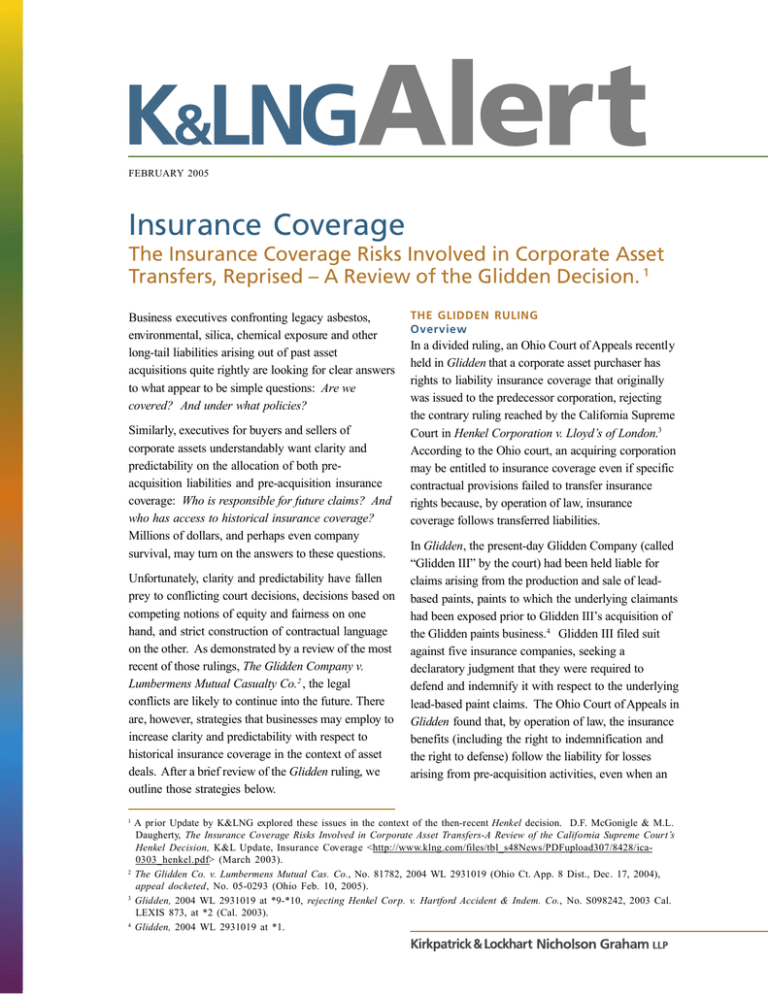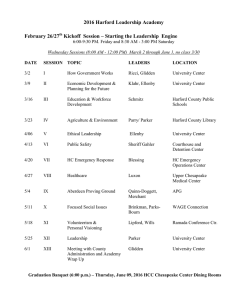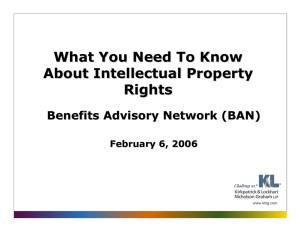
FEBRUARY 2005
Insurance Coverage
The Insurance Coverage Risks Involved in Corporate Asset
Transfers, Reprised – A Review of the Glidden Decision. 1
Business executives confronting legacy asbestos,
environmental, silica, chemical exposure and other
long-tail liabilities arising out of past asset
acquisitions quite rightly are looking for clear answers
to what appear to be simple questions: Are we
covered? And under what policies?
Similarly, executives for buyers and sellers of
corporate assets understandably want clarity and
predictability on the allocation of both preacquisition liabilities and pre-acquisition insurance
coverage: Who is responsible for future claims? And
who has access to historical insurance coverage?
Millions of dollars, and perhaps even company
survival, may turn on the answers to these questions.
Unfortunately, clarity and predictability have fallen
prey to conflicting court decisions, decisions based on
competing notions of equity and fairness on one
hand, and strict construction of contractual language
on the other. As demonstrated by a review of the most
recent of those rulings, The Glidden Company v.
Lumbermens Mutual Casualty Co.2 , the legal
conflicts are likely to continue into the future. There
are, however, strategies that businesses may employ to
increase clarity and predictability with respect to
historical insurance coverage in the context of asset
deals. After a brief review of the Glidden ruling, we
outline those strategies below.
1
2
3
4
THE GLIDDEN RULING
Overview
In a divided ruling, an Ohio Court of Appeals recently
held in Glidden that a corporate asset purchaser has
rights to liability insurance coverage that originally
was issued to the predecessor corporation, rejecting
the contrary ruling reached by the California Supreme
Court in Henkel Corporation v. Lloyd’s of London.3
According to the Ohio court, an acquiring corporation
may be entitled to insurance coverage even if specific
contractual provisions failed to transfer insurance
rights because, by operation of law, insurance
coverage follows transferred liabilities.
In Glidden, the present-day Glidden Company (called
“Glidden III” by the court) had been held liable for
claims arising from the production and sale of leadbased paints, paints to which the underlying claimants
had been exposed prior to Glidden III’s acquisition of
the Glidden paints business.4 Glidden III filed suit
against five insurance companies, seeking a
declaratory judgment that they were required to
defend and indemnify it with respect to the underlying
lead-based paint claims. The Ohio Court of Appeals in
Glidden found that, by operation of law, the insurance
benefits (including the right to indemnification and
the right to defense) follow the liability for losses
arising from pre-acquisition activities, even when an
A prior Update by K&LNG explored these issues in the context of the then-recent Henkel decision. D.F. McGonigle & M.L.
Daugherty, The Insurance Coverage Risks Involved in Corporate Asset Transfers-A Review of the California Supreme Court’s
Henkel Decision, K&L Update, Insurance Coverage <http://www.klng.com/files/tbl_s48News/PDFupload307/8428/ica0303_henkel.pdf> (March 2003).
The Glidden Co. v. Lumbermens Mutual Cas. Co., No. 81782, 2004 WL 2931019 (Ohio Ct. App. 8 Dist., Dec. 17, 2004),
appeal docketed, No. 05-0293 (Ohio Feb. 10, 2005).
Glidden, 2004 WL 2931019 at *9-*10, rejecting Henkel Corp. v. Hartford Accident & Indem. Co., No. S098242, 2003 Cal.
LEXIS 873, at *2 (Cal. 2003).
Glidden, 2004 WL 2931019 at *1.
attempted transfer of insurance rights by contract
failed when executed by the incorrect party (i.e., the
parent of the insured).5 In so ruling, Glidden rejected
the oft-discussed Henkel decision, prompted a dissent
and illustrated the conflicting decisions dealing with
insurance rights arising out of asset deals.
The Transactional Background
Glidden involved a particularly complicated corporate
history, as outlined at pages 2-4 of the ruling. That
complexity notwithstanding, two salient points
emerge from the opinion: 1) Glidden III was a
corporate entity distinct from the original
policyholders that had succeeded to the certain
historical assets and liabilities of the Glidden paint
business and 2) a letter agreement purporting to
transfer certain insurance rights was ineffective
because the transferor did not possess the insurance
rights it sought to transfer. These factors eventually
led to the court’s operation of law ruling. To place the
opinion in context, however, a brief review of the
corporate history is in order.
The Pre-Deal History
Glidden involved a series of mergers and acquisitions.
The chain of corporate transactions began with the
original SCM, which existed from 1924 to 1986, and
the original Glidden I, which existed from 1917 to
1967 and manufactured and sold lead-based paints
and pigments that were used in paints. In 1967,
Glidden I merged into SCM and thereafter was known
as SCM’s Glidden-Durkee Division.5 The policies at
issue in the Glidden case named both Glidden I and
SCM as insureds and were in effect from 1959 to
1987.
The Formation of Glidden III
Following Glidden I’s merger with SCM, the company
participated in a series of significant mergers and
acquisitions, which culminated in the formation of
Glidden III. In 1986, HSCM Industries, Inc. (HSCM-1,
Inc.), an indirect subsidiary of Hanson Trust Plc.
(“Hanson”), acquired control of SCM by a stock
5
6
7
8
tender. Thereafter, HSCM-1, Inc. liquidated SCM by
transferring stock ownership of SCM to certain
indirect subsidiaries of Hanson. Pursuant to this
liquidation, the coatings and resins division of SCM
was transferred to another subsidiary of Hanson called
HSCM-6, Inc.6 Hanson agreed to sell HSCM-6, Inc. to
ICI American Holdings, Inc. (“ICI”). One week later
HSCM-6, Inc.’s name was changed to The Glidden
Company (“Glidden II”).
Prior to the October 31, 1986 closing, ICI assigned its
rights under the Purchase and Sale Agreement to two
of its wholly-owned subsidiaries, Atkemix Seven, Inc.
and Atkemix Eight, Inc. On December 30, 1986,
Glidden II was liquidated and its assets were
distributed to Atkemix Seven, Inc. and Atkemix Eight,
Inc., after which Atkemix Eight, Inc. was renamed ‘The
Glidden Company’ (“Glidden III”). In 1987, Glidden
III acquired Atkemix Seven, Inc. (then known as the
Macco Company).
The Letter Agreement
Significantly, the Purchase and Sale Agreement between Hanson and ICI called for a sharing of the preclosing liabilities of the paint business, with Hanson
retaining ownership of all insurance policies. In addition to the Purchase and Sale Agreement, the parties
executed a side letter agreement of the same date providing that Hanson would give ICI and its subsidiaries
the benefit of those policies to the extent that they
provided coverage for pre-acquisition liability.7
The Ohio Appellate Court Ruling
The trial court ruled that, because of ICI’s 1986
acquisition of Glidden, Glidden III was not entitled to
claim rights under insurance policies that were issued
to SCM (or any division thereof) or to The Glidden
Company (as the corporation existed prior to its 1967
merger with SCM).8 In finding that Glidden III was
not insured under any of the policies at issue, the trial
court followed the line of reasoning adopted by the
California Supreme Court in Henkel, noting that the
policy language restricts the insurer’s obligations to
Id. at *10.
The Glidden Co., 2004 WL 2931019 at *1.
The side Letter Agreement provided that: “Hanson shall give ICI and its subsidiaries the benefit of any policy of insurance to the
extent the same would provide cover for liability in respect of occurrences relating to the Business prior to Closing giving rise to loss,
injury, or damage thereafter subject to indemnity on costs.” Glidden, 2004 WL 2931019 at *2 (quoting side Letter Agreement
between Hanson and ICI).
Id. at *5.
2 FEBRUARY 2005
KIRKPATRICK & LOCKHART NICHOLSON GRAHAM LLP
the insured, and does not necessarily follow the
insured’s liabilities.9 This approach adopts a strict
contractual interpretation approach and does not
authorize insurance rights to transfer by operation of
law. Furthermore, the trial court held that the parties
failed to effectuate the assignment of claims in the
letter agreement because said claims had not been
reduced to a sum of money due or become due under
the policy.
From that point, however, the Ohio Court of Appeals
moved beyond the strict construction approach.
Rather than simply conclude that Glidden III did not
have insurance rights because the Letter Agreement
failed to transfer them, the court ruled that Glidden III
was, in fact, entitled to coverage under the historical
policies by ruling that the historical insurance
coverage follows the historical liabilities by operation
of law.13
The appellate court reversed, holding that Glidden III
was entitled to defense and indemnity costs under
those policies that were issued before its acquisition of
the paints business because the insurance benefits
follow the liability for losses arising from preacquisition activities by operation of law.10 In so
holding, the appellate court noted the split in
authority on the issue and rejected the line of
reasoning adopted by the trial court as derived from
the holding in Henkel. 11
In adopting the operation of law approach, the
appellate court noted that a variety of situations
require insurance coverage to transfer as a matter of
law, and did not treat any of them as requiring a
particularly different result. Specifically, the court
explained that coverage of a predecessor corporation
transferring to a surviving corporation after a merger
does not result in increased risk to an insurer.14 The
court also explained that insurance coverage
(including rights to indemnity and defense) usually
transfers by operation of law to a successor
corporation in product-line successor cases for pre-sale
occurrences.15 The court extended this ruling to also
apply to contractual assumption of liability, such as
took place with respect to Glidden III and its
predecessors.
Significantly, the record reflected Hanson and ICI’s
attempt to transfer historical insurance rights for preacquisition liabilities through the side letter
agreement they executed. Nevertheless, employing an
analysis somewhat reminiscent of the strict
construction approach found in decisions such as
Henkel, the appellate court found that the side letter
agreement did not serve to transfer insurance rights
because Hanson was a parent company and “an
insurance policy issued to a subsidiary does not
automatically cover the parent.”12 Therefore, because
Hansen was not a party to the original insurance
contracts, it could not transfer any rights and duties
under those policies to ICI.
In reaching this ruling, the appellate court discussed
and rejected the Henkel line of reasoning that the
defendant insurance companies had urged.16 In
Henkel, the Henkel Corporation had acquired a
product line of another company and assumed all
related liabilities.17 The California Supreme Court
held that coverage follows liability only in those
specific instances when liability was imposed as a
9
Id. at *8 (noting that the insurance companies urged the appellate court to reject the operation of law theory); citing
Henkel 129 Cal. Rptr. 2d at 835-38.
10
Glidden, 2004 WL 2931019 at *10.
11
Id.
12
Id. at *6.
13
Although the court found that the insurers’ anti-assignment clause arguments were moot because the insurance transferred
by operation of law, the court did observe that “a majority of courts refuse to enforce anti-assignment provisions against
claims for pre-assignment losses.” Id. at *7, n. 8, citing Northern Ins. Co. of N.Y. v. Allied Mutual Ins. Co., 955 F.2d 1353,
1357-58 (9th Cir. 1992), cert. denied, 505 U.S. 1221; B.S.B. Diversified Co. v. American Hardware Mutual Ins. Co., 947
F. Supp. 1476 (W.D. Wash. 1996); Total Waste Management Co. v. Commercial Union Ins. Co., 857 F. Supp. 140, 148
(D.N.H. 1994).
14
Id., citing Knoll Pharmaceutical Co. v. Automobile Ins. Co., 167 F. Supp. 2d 1004 (N.D. Ill. 2004).
15
The Glidden Co., 2004 WL 2931019, *8, citing Northern Insurance Co. of New York v. Allied Mut. Ins. Co., 955 F.2d
1353, 1357 (9th Cir. 1992).
16
Id. at *8, n.10.
17
For a more detailed discussion of the Henkel case and its impact on the transfer of insurance benefits, see the K&LNG
Update referenced in note 1 above.
3 FEBRUARY 2005
KIRKPATRICK & LOCKHART NICHOLSON GRAHAM LLP
matter of law.18 The court noted that liability was not
being imposed upon the Henkel Corporation by law,
but rather by its contractual assumption of liability.19
Therefore, the court limited the Henkel Corporation’s
rights as a successor to those that were defined and
limited by the contract. The contract did not specify
that the insurance coverage transferred along with the
liability; therefore, the court held that it could not
transfer coverage, meaning that the Henkel Corporation had acquired the seller’s liability without
acquiring the corresponding insurance coverage.20
The court in Henkel also held that, because the policy
benefits were assigned without the insurer’s consent,
the assignment violated the anti-assignment clause of
the contract.21
Glidden reasoned that the contract-based approach
which the court in Henkel adopted is contrary to wellsettled law and is contrary to the general rule that after
a loss has occurred, policy benefits can be assigned
without insurers’ consent and without regard to an
anti-assignment clause.22 The court in Glidden agreed
with the dissent in Henkel, by refusing “to enforce
anti-assignment provisions against claims that arise
from pre-assignment occurrences.”23 The court in
Glidden explained that, if it were to hold that the
defendant insurance companies were not obligated to
provide coverage to Glidden III, the agreed premium
would result in an unfair windfall to those insurers,
which would owe no coverage on a risk which they
had promised to insure against and for which they
were paid a premium.24
Again citing the reasoning of the dissent in Henkel,
Glidden pointed out the disproportionate exposure
18
19
20
21
22
23
24
25
26
27
28
29
that a successor company would face after assuming
the risk of liability for the torts of a predecessor
without also receiving the benefits of the predecessor’s
insurance coverage for presale occurrences.25 The
court reasoned that it would be nearly impossible for
such a company to obtain insurance coverage for
injuries that have already occurred before the
successor’s acquisition of the business. The court
noted the chilling effect that such a scenario would
likely have, as it would undoubtedly restrict corporate
restructuring, mergers, and sales.26
The defendant insurance companies contended that
coverage should not transfer by operation of law
because such a transfer would burden them with
increased risks that they did not agree to.27 The court
also rejected this argument, noting that several courts
have recognized that no such increased risk exists
when the duty to indemnify and defend relates to
events that occurred prior to transfer because “when
the activities giving rise to the damage or loss occur
during the term of the policy and prior to any transfer
of assets, the risk is no greater than when the policy
was written.”28 In sum, the court held that, when the
coverage passes by operation of law, the insurer faces
no more risk than that to which it initially agreed.
A single judge dissented from the Glidden ruling,
declining to join the majority’s conclusion that
insurance rights transfer to a successor corporation by
operation of law. The dissenting judge adopted the
rationale behind the Henkel case, contending that “the
contractual nature of insurance policies” should
control the issue.29
Henkel, 129 Cal. Rptr. 2d at 833 (noting that an asset purchaser may be subjected to liability under three broad criteria that
focus upon the transaction itself: (1) when the transaction amounts to a consolidation or merger of the two corporations; (2)
when the purchasing corporation is a mere continuation of the seller; or (3) when the transfer of assets is for the fraudulent
purpose of escaping liability. The court reviewed these three situations and concluded that none of them applied to
Henkel).
Id. at 833.
Id. at 834.
Id.
The Glidden Co., 2004 WL 2931019 at *9, citing Henkel, 129 Cal. Rptr. 2d at 837 (Moreno, J., dissenting).
The Glidden Co., 2004 WL 2931019 at *9.
Id. at *10, quoting Henkel, 129 Cal Rptr. 2d at 841 (Moreno, J., dissenting).
The Glidden Co., 2004 WL 2931019 at *10.
Id.
Id. at *9.
Id. at *9, citing Northern Insurance Co., 955 F.2d at 1358.
The Glidden Co., 2004 WL 2931019 at *13 (McMonagle, J., dissenting).
4 FEBRUARY 2005
KIRKPATRICK & LOCKHART NICHOLSON GRAHAM LLP
CONCLUSION
While Glidden will be welcomed by many
policyholders,30 it also serves to illustrate the sharp
divisions that exist in the case law on the treatment of
historical insurance coverage in asset transactions.
Strategies that businesses may take in response to this
uncertain legal environment include the following:
■
■
■
30
Survey the Legal Landscape – As demonstrated
above, questions of insurance policy interpretation
and the effects of corporate successorship rulings
are governed by state law, which can vary
substantially. Consequently, in assessing past
exposures and in preparing for future transactions,
businesses should undertake a careful review of the
likely governing law that may apply to questions
of insurance coverage rights. Because of the varied
rulings under different state law, understanding the
state law or laws that may apply to past and future
transactions is crucial.
Expect Conflicting Law When Drafting – In many
cases, efforts to assess the legal landscape will
prove inconclusive. Thus, asset transactions
should be documented, to the extent possible, to be
responsive to conflicting rules of law. Depending
upon the parties’ objectives (e.g., to transfer
insurance rights, or to preserve rights), the parties to
a transaction might explore covenants that preserve
their intent and allocate risks and benefits,
regardless of what a future court may do in an
action against insurers.
■
Consider Approaches to Insurers – Insurance
policies, while governed by special rules and
performing important public policy functions, are
creatures of contract. As such, corporate
policyholders faced with questions regarding rights
under historical insurance policies and future
policies for current transactions may wish to
consider an approach to their insurers for consent
to insurance rights transfers, whether past or
prospective. While such inquiries may not be
practical options and are likely to be met with
resistance or ignored, simply making the request
may assist in a future litigation.
Glidden, and the decisions that preceded it, teach that
clarity and predictability on the questions of the
insurance rights arising out of asset deals will remain
elusive. Careful businesses would be wise to analyze
their particular circumstances closely, therefore, with
reference to the considerations set forth above.
David F. McGonigle
dmcgonigle@klng.com
412.355.6233
Elizabeth S. Windsor
ewindsor@knlg.com
412.355.8922
Consider Remedial Measures – In many cases, the
insurance rights for legacy liabilities will be
determined by historical contractual provisions. If
circumstances permit, amendments to historical
transaction documents – particularly internal
restructuring done for tax and other reasons – may
be in order.
In some cases, policyholders may have expressly contracted against a transfer of insurance benefits for a number of reasons.
These could include, for example, a desire to preserve insurance limits for the transferor corporation or a desire to avoid the
potential imposition of obligations under retrospective premium agreements and other self-insurance features. Because the
Glidden decision did not expressly address such a situation, it is unclear what, if any, impact the decision may have on such
transactions. In such cases, however, the parties may be well-served to craft contractual provisions that provide for
implementing the parties’ intentions, regardless of what a future court may rule.
5 FEBRUARY 2005
KIRKPATRICK & LOCKHART NICHOLSON GRAHAM LLP
The Insurance Coverage practice group at Kirkpatrick & Lockhart Nicholson Graham LLP offers an international
policyholder-oriented practice on behalf of Fortune 500 and numerous other policyholder clients. Its lawyers have
authored Policyholder’s Guide to the Law of Insurance Coverage and edited the Journal of Insurance Coverage . For
further information, please consult our website at www.klng.com.
International Contact
Boston
Dallas
Harrisburg
London
Los Angeles
Miami
Newark
New York
Pittsburgh
San Francisco
Washington
Peter J. Kalis
John M. Edwards
Robert Everett Wolin
Carleton O. Strouss
John Magnin
David P. Schack
Daniel A. Casey
Anthony P. La Rocco
Eugene R. Licker
James R. Segerdahl
Edward P. Sangster
Matthew L. Jacobs
pkalis@klng.com
jedwards@klng.com
rwolin@klng.com
cstrouss@klng.com
jmagnin@klng.com
dschack@klng.com
dcasey@klng.com
alarocco@klng.com
elicker@klng.com
jsegerdahl@klng.com
esangster@klng.com
mjacobs@klng.com
+1.412.355.6562
+1.617.261.3123
+1.214.939.4909
+1.717.231.4503
+44 (0) 20 7648 8168
+1.310.552.5061
+1.305.539.3324
+1.973.848.4014
+1.212.536.3916
+1.412.355.6784
+1.415.249.1028
+1.202.778.9393
Fax +1.412.355.6501
Fax +1.617.261.3175
Fax +1.214.939.4949
Fax +1.717.231.4501
Fax +44 (0) 20 7648 9001
Fax +1.310.552.5001
Fax +1.305.358.7095
Fax +1.973.848.4001
Fax +1.212.536.3901
Fax +1.412.355.6501
Fax +1.415.249.1001
Fax +1.202.778.9100
www
w.. k l n g . c o m
BOSTON
■
DALLAS
■
HARRISBURG
■
LONDON
■
LOS ANGELES
■
MIAMI NEWARK
■
■
NEW YORK PITTSBURGH
■
■
SAN FRANCISCO
■
WASHINGTON
Kirkpatrick & Lockhart Nicholson Graham is a combination of two limited liability partnerships, each named Kirkpatrick & Lockhart Nicholson Graham LLP, one established in Delaware, USA,
and one incorporated in England.
This publication/newsletter is for informational purposes and does not contain or convey legal advice. The information herein should not be used or relied upon in regard to any particular facts
or circumstances without first consulting a lawyer.
Unless otherwise indicated, the lawyers are not certified by the Texas Board of Legal Specialization.
Data Protection Act 1998 - We may contact you from time to time with information on Kirkpatrick & Lockhart Nicholson Graham LLP seminars and with our regular newsletters, which may be
of interest to you. We will not provide your details to any third parties. Please e-mail cgregory@klng.com if you would prefer not to receive this information.
© 2005 KIRKPATRICK & LOCKHART NICHOLSON GRAHAM LLP. ALL RIGHTS RESERVED.






